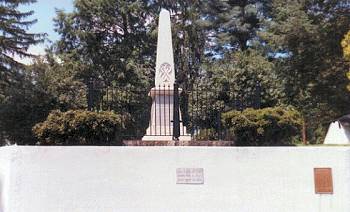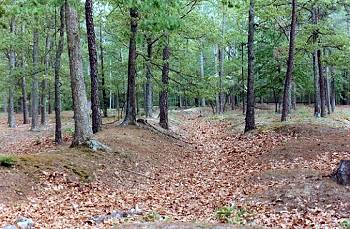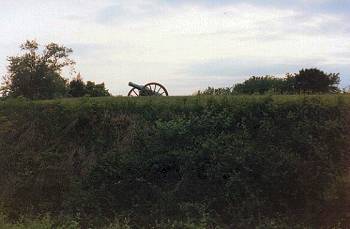|
(5-84) Yellow
Tavern
On May 8, 1864,
Union General Phil Sheridan, with 10,000 Federal cavalry, slipped away
from Spotsylvania Court House and headed south toward Richmond. His
objective was to prove he could whip J.E.B. Stuart, and he got his chance
just north of Richmond at the small village of Yellow Tavern.
The battle that ensued was a victory for Sheridan, and it cost J.E.B.
Stuart his life. This monument sits on the approximate spot where Stuart
was mortally wounded
Ed Conner Photo |
|
(5-84) Yellow
Tavern
Side view of Stuart's monument at Yellow Tavern, VA. It was
on this spot that Stuart was rallying his troopers after the Confederate
line had been breached. One of General George A. Custer's dismounted
troopers, Pvt. John A. Huff of the 5th Michigan Cavalry, was running
across the front of the Confederate line when he spotted a group of
mounted Confederate officers. He fired a snap-shot with his pistol at the
group as he ran by; the shot hit J.E.B. Stuart in the stomach, inflicting
a mortal wound. Stuart was evacuated to Richmond, where he died the next
day.
The village of Yellow Tavern no longer exists, and the entire battlefield
has fallen victim to urban sprawl. This monument is located in a
residential area and is maintained by the United Daughters of The
Confederacy
Ed Conner Photo |
|
(5-84) Cold
Harbor
Remains of Confederate trench works at Cold Harbor. On June
3, 1864, General U.S. Grant launched an assault on these Confederate
trenches with disastrous results. In 30 minutes time, over 7000 Federal
infantry lay dead or wounded in front of the Confederate breastworks. Most
of the wounded lay where they fell for four days due to a disagreement
between Grant and Lee over cease-fire terms; few survived.
Many years later, Grant said of the assault at Cold Harbor, "I have always
regretted that the last assault at Cold Harbor was ever made. No advantage
whatever was gained to compensate for the heavy losses we sustained.
Indeed the advantages other than those of relative losses, were on the
Confederate side"
Ed Conner Photo |
|
(5-84) Fort
Hoke
 Fort Hoke courtesy of William Bozic, TX (July
2006)
Fort Hoke courtesy of William Bozic, TX (July
2006)
Fort Hoke, one of the line of forts protecting the southern
approach to Richmond. After Cold Harbor, Grant decided to attack this line
that consisted of Forts Harrison, Gilmer, Gregg, Johnson, Hoke and Battery
Alexander.
The results of these attacks were less than spectacular; Fort Hoke marked
the deepest penetration of this defense line. Captured by Federal forces
on September 29, 1864. It was abandoned by the Federals shortly after it's
capture while the Union forces consolidated at Fort Harrison. Fort Hoke
became an integral part of a new Confederate defense line
Ed Conner Photo |



